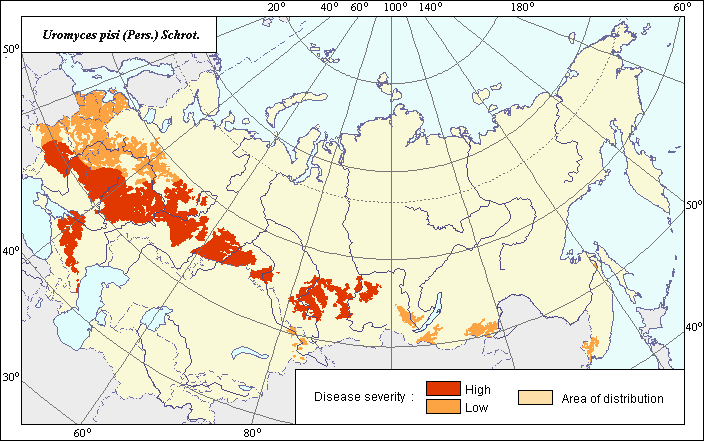Diseases
Distribution and disease severity zones of Rust of Peas (Uromyces pisi (Pers.) Schrot. and U. fabae DB. f. pisi-sativae Hiratsuka)
 Object description Download GIS-layers
Object description Download GIS-layers
Authors.
Specialist-biologist - Kungurtseva O.V., GIS-specialist - Saulich M.I.Date of creation.
22.10.2004.Scale.
1:20 000 000.Accuracy of map.
It is created on information taken from the open-published literature and maps of scale 1: 33 000 000.Projection.
"Alber's Equal Area Conic", 9, 1001, 7, 100, 0, 44, 68, 0, 0.Basic contents.
The vector map is composed of 3 thematic layers. Zones of distribution and disease severity are shown by polygons.Accuracy of the classifier.
Within the limits of the disease area two zones of severity are allocated that coincide with the greatest areas of peas culture growing. In the zone of high severity the Rust development gets character of epiphytoty in damp years and results in reduction of yield by 30%. In the zone of low severity the disease develops sparsely and rarely, having no appreciable harm.Procedure of the map drawing.
Severity and distribution zones for the Rust of Peas are drawn on a map according to the literature data published in the open press. The analysis of the data has shown that the Rust is the most dangerous disease in the Central Black Earth zone of Russia, Volga Basin Region, Forest-Steppe Ukraine, Western Siberia, and Ural (Evdokimova et al., 1992; Korobeinikova et al., 1964; Mikhailenko, 1971; Morozova et al., 1964; Proskuryakova, 1989). Weak development of the disease is marked in Non-Chernozem and Central zones of Russia, in Baltic States, Byelorussia, and Eastern Siberia (Brundza, 1961; Dorozhkin et al., 1978; Chumakov et al., 1962). The zone of the disease distribution is adjusted to areas of the greatest distribution of peas according to I.E. Koroleva's vector layer (Koroleva et al., 2003). A vectoring of the scanned raster map with the image of disease distribution and severity is carried out by standard GIS-technologies.Sources of the data.
Brundza K. 1961. Fungi parasitizing on cultivated plants in Lithuania and some questions of their biology. VilТnyus: Academy of sciences of Lithuanian SSR. Institute of botany. 302 p. (in Russian).Chumakov, A.E., Fratkin, A.B. & Vlasov Yu.I. 1962. Pests and diseases of the legumes. Leningrad and Moscow: Sel'khozgiz. 85 p. (in Russian).
Dorozhkin, N.A., Chekalinskaya, N.I. & Nitievskaya V.I. 1978. The diseases of Legumes in BSSR. Minsk: Nauka i tekhnika. 192 p. (in Russian).
Evdokimova E.G., Matyushin M. S., Fadeeva A.N., Shalamova A.A. 1992. Pea field of Tatarstan. KazanТ: Tatar Publishing House. 120 p. (in Russian).
Korobeinikova A.V., Fominykh A.S. 1964. Pests and diseases of legumes and their control. Sverdlovsk: Sredne-UralТskoe Publishing House. 48 p. (in Russian).
Mikhailenko, M.A. 1971. Peas in West Siberia. Omsk: West Siberian Publishing House, 283 p. (in Russian).
Morozova A.M., Shevchenko I.S. 1964. Pests and diseases of leguminous plants. Volgograd: Volgograd Publishing House, 23 p. (in Russian).
Proskuryakova G.I. 1989. Affection of collection kinds of peas by Rust agent (Uromyces pisi Schroet.). Nauchno-tekhnicheskii byulletenТ VIR (Leningrad) 193: 34-36 (in Russian).
Right and copyright:
All rights reserved.Copyright 2004 © O.V.Kungurtseva & M.I.Saulich (vector map, description), O.V.Kungurtseva (photo).

